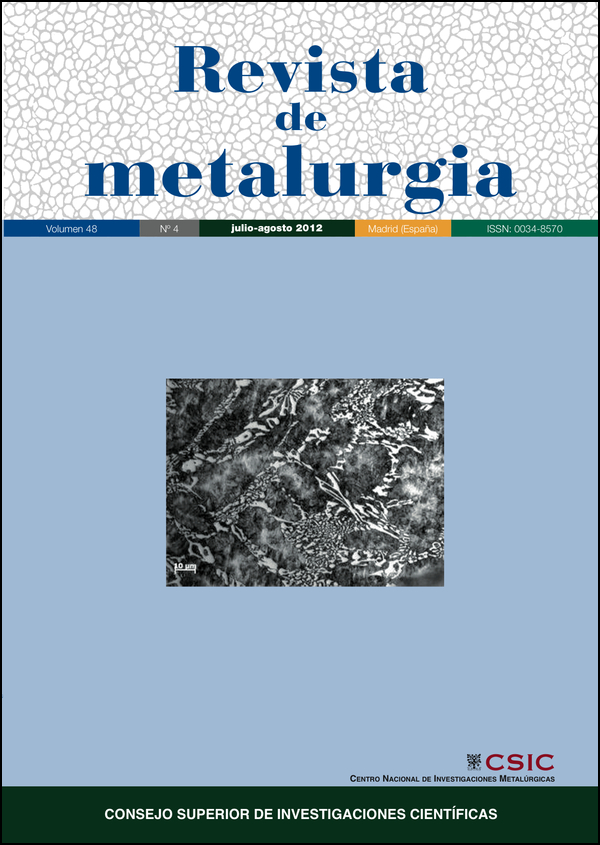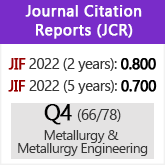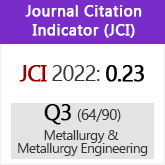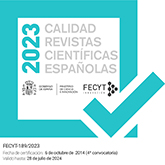Friction and bending forces evaluation of AISI 304 DDQ steel sheet forming by bending tests under deep-drawing multiaxial stresses
DOI:
https://doi.org/10.3989/revmetalm.1202Keywords:
AISI 304 Stainless steel, Bending under tension, Friction, Deep-drawingAbstract
Die radius is a critical area from the viewpoint of friction in forming processes. Moreover the sheet, that has been previously deformed in flange area, suffers bending and unbending stresses. Then, die-sheet contact in die radius must be especially considered in order to guarantee the suitable lubrication conditions. In the present work, a test method is carried out for evaluating an AISI 304 DDQ steel under similar conditions to those existing in the die radius area and that, usually, are not really reproduced in traditional bending under tensions tests. Deformation under pure shear condition, the bending and the radius angle have been established as variables of the tests. Results allow to obtain the apparent pressure sheet-bending tool, that increases with bending angle and decreases with tool radius. This last variable is the most significant while the bending angle has lesser influence. Although experimental results present some concordances with values obtained by analytical methods, some corrections must be considered in them in order to improve the theoretical values.
Downloads
References
[1] D.P. Kotchman, I. Kim, C.-Y. Sa, y D. Lee, J. Mater. Eng. Perform. 4 (1992) 555-564. http://dx.doi.org/10.1007/BF02682693
[2] D.W. Vallance y D.K. Matlock, J. Mater. Eng. Perform. 1 (1992) 685-693. http://dx.doi.org/10.1007/BF02649250
[3] S. Hao, B.E. Klamecki y S. Ramalingam. Wear 224 (1999) 1-7. http://dx.doi.org/10.1016/S0043-1648(98)00288-9
[4] A. Azushima, M. Yamamiya y H. Kudo, CIRP Annals Manufacturing Technology 1 (1992) 259-262. http://dx.doi.org/10.1016/S0007-8506(07)61199-8
[5] A. Azushima y M. Sakuramoto. CIRP Annals Manufacturing Technology, 1 (2006) 303-306. http://dx.doi.org/10.1016/S0007-8506(07)60422-3
[6] P. K. Saha y W. R. D. Wilson, Wear, 172 (1994) 167-173. http://dx.doi.org/10.1016/0043-1648(94)90284-4
[7] M. P. Pereira, J. L. Duncan, W. Yan y B. F. Rolfe, J. Mater. Proc. Tech. 209 (2009) 3.532-3.541.
[8] M. P. Pereira, W. Yan y B. F. Rolfe, Wear 265 (2008) 1.687-1.699.
[9] K. Hanaki y K. Kato, Adv. Technol. Plasticity 1 (1984) 581-586.
[10] G. J. Coubrough, M. J. Alinger y C. J. Van Tyne, J. Mater. Proc. Tech. 130-131 (2002) 69-75. http://dx.doi.org/10.1016/S0924-0136(02)00781-1
[11] J. Andreasen, D. Olsson, y K. Chodnikiewicz, Proc. IME B J. Eng. Manufact. 1 (2006) 73-80.
[12] V. Miguel, J. Coello, A. Calatayud, M.C. Manjabacas, A. Martínez y C. Ferrer, J. Mater. Proc. Tech. 1 (2009) 1.588-1.596.
[13] J. Coello, V. Miguel, A. Calatayud, A. Martínez y C. Ferrer, Rev. Metal. Madrid 5 (2010) 435-445.
[14] V. Miguel-Eguía, Investigación de la metodología para la determinación de los indicadores de deformación y de cohesión en tensiones multiaxiales de embutición plana. Aplicación del acero electrocincado DC-05, Universidad Politécnica de Valencia, 2005.
[15] J. Coello, V. Miguel, C. Ferrer, A. Calatayud y A. Martínez, Rev. Metal. Madrid 6 (2008) 503-512.
[16] Z. Marciniak, J.L Duncan y S. J. Hu, Mechanics of sheet metal forming. Ed. Butterworth- Heinemann; 2nd ed; UK, 2002.
[17] V. Miguel, J. Coello, M. C. Manjabacas, A. Calatayud, C. Ferrer y A. Martínez, J. Tribol, 1 (2011) 1-9.
[18] F.J. Avellaneda, V. Miguel, J. Coello, A. Martinez y A. Calatayud, IV Manufacturing Engineering Society International Conference, American Institute of Physics (en fase de publicación).
Downloads
Published
How to Cite
Issue
Section
License
Copyright (c) 2012 Consejo Superior de Investigaciones Científicas (CSIC)

This work is licensed under a Creative Commons Attribution 4.0 International License.
© CSIC. Manuscripts published in both the printed and online versions of this Journal are the property of Consejo Superior de Investigaciones Científicas, and quoting this source is a requirement for any partial or full reproduction.All contents of this electronic edition, except where otherwise noted, are distributed under a “Creative Commons Attribution 4.0 International” (CC BY 4.0) License. You may read here the basic information and the legal text of the license. The indication of the CC BY 4.0 License must be expressly stated in this way when necessary.
Self-archiving in repositories, personal webpages or similar, of any version other than the published by the Editor, is not allowed.


















